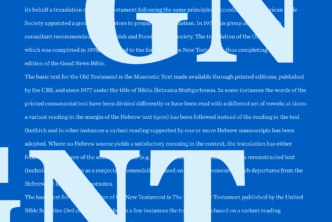I like to say to students that, in ancient Greek, verbs are where the action is. It’s a tongue-in-cheek acknowledgement that, of course, verbs are doing words, but also that verbs are centrally significant for the way that ancient Greek functions. The verbal system is the engine room of the Greek language.
Given their great power for communication, it’s no surprise that Greek verbs are complicated. There’s aspect, voice, mood, person, and number to consider, making Greek verbs highly inflected—each verb-form communicates a great deal, and verbs require much unpacking. Basic reading of Greek requires us to be able to decode all the inflected information in each verb-form. But how do we go beyond the basics? How should we approach Greek verbs to better appreciate their contribution to each Greek sentence and paragraph? And how much reward is there for going deeper with Greek verbs?
From a negative point of view, a good understanding of Greek verbs will enable us to assess and critique some of the scholarly conclusions reached about various Greek passages. New Testament commentaries frequently engage with the Greek text as a matter of course and often build the case for their conclusions using arguments arising from their understanding of Greek verbs. These conclusions then filter down to classes or sermons heard in church on Sunday. Teachers and pastors consult the commentaries and shape their content around the conclusions reached there. Lectures and sermons affect the understanding of regular people, who take their teachers’ or pastors’ conclusions to their Bible discussion groups, and before we know it the view that originated in the commentary has become folklore.
But what if the original argument was flawed? What if the argument hinged on a misinformed understanding of the Greek verbal system? What if our understanding of biblical texts has been distorted, even just a little, by incorrect handling of Greek verbs?
If you think such a phenomenon is rare, my sense is that it’s more common than you think. Understanding Greek verbs matters.
From a positive point of view, a good understanding of Greek verbs will enable us to see how narratives are shaped and to see new possibilities for exegesis that were previously hidden from view. We will be able to describe verbal usage in a manner that is accurate, coherent, and neither too precise nor too vague. All these things are useful advances.
Related article: Is New Testament Greek the Most Precise Language Known to Mankind?
The two main areas that have attracted scholarly attention in recent years are verbal aspect and voice. While the discussions about voice are significant, including the abolishment of the category of deponency, here we will focus on verbal aspect and its partner in crime, Aktionsart.1 In what follows I will offer a simplified overview of what aspect is, how it relates to Aktionsart, and how the two categories together can shape the way we understand Greek verbs and therefore the texts to which they powerfully contribute.
Verbal aspect
Within the study of linguistics there are different ways in which the term aspect is used, but the standard meaning—and the one adopted most widely within Κοινή Greek linguistics—is that aspect refers to viewpoint. The viewpoint is the way in which a verb is used to view an action, either from outside the action or from inside it. Buist Fanning describes aspect thus:
The action can be viewed from a reference-point within the action, without reference to the beginning or end-point of the action, but with a focus instead on its internal structure or make-up. Or the action can be viewed from a vantage-point outside the action, with focus on the whole action from beginning to end, but without reference to its internal structure.2
The external viewpoint (outside the action) is known as perfective aspect; the internal viewpoint (inside the action) is known as imperfective aspect. Perfective aspect views an action “from a distance,” as a whole, and is often used to present an action in summary form—this happened, that happened—without reference to how it happened and without viewing it as though happening. Imperfective aspect views an action “up close,” from within it, and is often used to present an action as unfolding or in progress—this was happening, that happens—without reference to the whole action.3
Greek scholars agree that the aorist tense-form is perfective in aspect: it is used to convey actions as a whole, and it frequently presents those actions in a summary fashion. Scholars also agree that the Greek present and imperfect are imperfective in aspect: they are used to convey an action as unfolding, frequently in progress or as a state. There is, however, lively debate about the aspect of the Greek perfect, pluperfect, and future tense-forms—but we won’t get into those debates here.4
Verbal aspect should be understood as distinct from, but related to, the categories of tense and Aktionsart. There has been some heated debate about tense in the ancient Greek verbal system, and we will side-step that here.5 Suffice to say that tense refers to how verbs are used to convey temporal reference—past, present, future, etc.—while aspect is about viewpoint and not temporal reference.
Aktionsart literally means “type of action,” and refers to the nature of action depicted by any particular verb. Is it punctiliar (happening in a point of time), stative (expressing a state or condition), iterative (happening repeatedly), etc.? Aktionsart is not the same as aspect, which is concerned with viewpoint (external or internal; perfective or imperfective), not the specific type of action that any particular verb conveys. However, aspect and Aktionsart relate to each other in some predictable ways, and having a basic grasp of these interactions can be very useful for exegesis of Greek verbs.
Aspect and lexemes
Before we can explore how aspect and Aktionsart interact, however, it is important to have some understanding of Greek verbal lexemes. This is because Aktionsart is a product of the combination of factors such as aspect, lexeme, and context. In order to appreciate how aspect affects our interpretation of Greek verbs, we need to talk about lexemes. The following discussion lays out some key categories that will help the budding interpreter of Κοινή Greek texts.
First it should be noted that lexical analysis can become very complicated, and this is not the place to wade into deeper waters. But second, the good news is that with some basic pointers, the interpreter will be able to engage the interpretative process outlined in the next section of this essay.
A fundamental distinction is the difference between transitive and intransitive lexemes. If an action is performed upon a subject, a verbal lexeme is said to be transitive. Some lexemes are obviously transitive because of the nature of the action they convey. For example, in English, lexemes such as “hit,” “give,” “kick,” “throw,” “arrange,” and so on are all transitive. If the action affects or impacts its object somehow, it will be transitive. If a lexeme is not transitive, it must be intransitive. An intransitive lexeme is one that does not require an object or does not perform an action upon its object. Whether or not a lexeme is intransitive is decided simply by what the type of action is. In English, lexemes such as “sleep,” “know,” “live,” “die,” and so on are all intransitive.6
Transitive and intransitive lexemes can be subcategorized in a million different ways, but it’s worth pointing to one subcategory each. A key subcategory of transitive lexemes is punctiliar action. A punctiliar action is performed on an object in an instantaneous fashion. It is a one-off, immediate action with very short duration. A lexeme can be labelled punctiliar if the action it conveys cannot be drawn out for any length of time. English lexemes such as “punch,” “kick,” “throw,” and so forth, are all punctiliar. Note that you can repeat a punctiliar action like punching, but one punch can’t last for two minutes (not even in slow motion!).
A key subcategory of intransitive lexemes, by contrast, is stativity. A stative verbal lexeme does not refer to an action performed upon an object, but instead describes a state of being. In fact, a stative lexeme does not really convey an action at all—it simply depicts a state. English lexemes such as “sleep,” “die,” and “decide” are all stative.
To summarize: in order to engage the interpretative process outlined in the next section of this article, we need to appreciate that some lexemes are transitive while other lexemes are intransitive. Of the transitive lexemes, some are also punctiliar. Of the intransitive lexemes, some are also stative.
Aspect and Aktionsart
In my textbook introduction, Basics of Verbal Aspect in Biblical Greek,7 I present a simplified method for understanding aspect and Aktionsart interactions in Κοινή Greek text. Drawing particularly on the work of Buist Fanning at this point, I acknowledge the usefulness of observing predictable patterns that emerge from the combinations of aspects with lexical types. The combination of aspect, lexeme, and context work together to create Aktionsart expressions, or implicatures.
While the aspect of a tense-form is fixed (aorists are always perfective in aspect; presents are always imperfective; etc.), the Aktionsart expression of each tense-form varies according to aspect, lexeme, and context. This means it is easy to determine which viewpoint each verb expresses (i.e., perfective aspect = external viewpoint; imperfective aspect = internal viewpoint), but the Aktionsart function of any particular verb is not so obvious. While older grammars and commentaries tend to make claims about the Aktionsarten of various verbs, such designations were generally intuited since there was no established method for analyzing Aktionsart.
In Basics of Verbal Aspect, I present a four-step process that identifies the key elements in exegeting the function of a verb in context. First, the aspect of the verb is identified (e.g., perfective aspect). Second, the type of lexeme must be taken into account (e.g., transitive: punctiliar). Third, relevant elements of the context are considered (e.g., a repeated action is implied). Finally, the Aktionsart is determined based on predictable patterns of the combinations of the previous three elements (e.g., iterative Aktionsart).
If, for example, we consider the aorist indicative tense-form and imagine its use with different kinds of lexemes in different contexts, the following outcomes would be possible:8
Aorist indicative
Summary Aktionsart
Perfective aspect with a non-punctiliar, non-stative lexeme can create a summary Aktionsart. This is the default function of the aorist indicative and simply expresses that something happened, without further specification.
Punctiliar Aktionsart
Perfective aspect with a punctiliar lexeme can create a punctiliar Aktionsart. This expresses an action that is once-occurring and instantaneous.
For example:
ἀλλ’ εἷς τῶν στρατιωτῶν λόγχῃ αὐτοῦ τὴν πλευρὰν ἔνυξεν, καὶ ἐξῆλθεν εὐθὺς αἷμα καὶ ὕδωρ.
But one of the soldiers pierced his side with a spear, and at once blood and water came out. (John 19:34)
- Aspectual meaning of the verb: The aorist indicative expresses perfective aspect.
- Contribution of the lexeme: The lexeme is punctiliar; it is an instantaneous action.
- Function in context: The context allows punctiliarity.
The punctiliarity of this action is obvious, given the nature of “piercing,” together with the immediate result of the action (“at once”). The point here, however, is that not all aorists are punctiliar (as is sometimes mistakenly claimed). It is this particular lexeme, in concert with perfective aspect, that creates a punctiliar Aktionsart. Moreover, if the same lexeme were used with imperfective aspect, rather than perfective, it would create an iterative Aktionsart. This would mean that the soldiers kept stabbing Jesus, which would be a very different picture from that presented by the aorist here.
Ingressive Aktionsart
Perfective aspect with a stative lexeme, in a context that indicates entrance into a state or sets a new direction, can create an ingressive Aktionsart. This expresses the entrance into a state or the beginning of a new action.
ἐν τῷ κόσμῳ ἦν, καὶ ὁ κόσμος δι’ αὐτοῦ ἐγένετο, καὶ ὁ κόσμος αὐτὸν οὐκ ἔγνω.
He was in the world, and the world was created through him, yet the world did not recognize him. (John 1:10)
- Aspectual meaning of the verb: The aorist indicative expresses perfective aspect.
- Contribution of the lexeme: The lexeme is stative.
- Function in context: The context allows the entrance into a state.
To recognize the Word, rather than simply to “know” him, views the action (“did not recognize”) as entrance into the state of knowledge. Here the verb is negated, so that the world did not come into this state.
Gnomic Aktionsart
Perfective aspect with any lexeme in a context of “general reality” can create a gnomic Aktionsart. This expresses a universal and timeless action.
οὓς δὲ προώρισεν, τούτους καὶ ἐκάλεσεν· καὶ οὓς ἐκάλεσεν, τούτους καὶ ἐδικαίωσεν· οὓς δὲ ἐδικαίωσεν, τούτους καὶ ἐδόξασεν.
And those he predestines, he also calls; and those he calls, he also justifies; and those he justifies, he also glorifies. (Rom 8:30)
- Aspectual meaning of the verb: The aorist indicatives express perfective aspect.
- Contribution of the lexeme: The lexemes are not punctiliar or stative.
- Function in context: The context suggests a gnomic reading.
This verse has been notoriously difficult for interpreters who take the aorists as past-referring—“those he predestined, he also called, and those he called, he also justified, and those he justified, he also glorified.” Since glorification is normally understood to occur in the future, interpreters tend to claim that the past-referring aorist “glorified” is used because the future is so certain that it can be claimed as being done already. This highly unlikely understanding is not necessary, however, once it is recognized that this string or aorists can be explained as gnomic in function. They do not refer to past events but to a series of activities that God performs—predestining, calling, justifying, and glorifying. As a general statement of reality, the gnomic reading does not require these actions to be locked into any specific timeframe.
Present aorist
Perfective aspect with any lexeme in a present referring context can implicate present temporal reference. Strictly speaking, this is not an Aktionsart, but is a special function of the aorist nonetheless.
For example:
καὶ φωνὴ ἐγένετο ἐκ τῶν οὐρανῶν· σὺ εἶ ὁ υἱός μου ὁ ἀγαπητός, ἐν σοὶ εὐδόκησα.
And a voice came from heaven: “You are my beloved Son; with you I am well-pleased.” (Mark 1:11)
No one takes the aorist here as past-referring. The context and theological concerns make its present temporal reference much more likely. To say that the voice from heaven was pleased (rather than is pleased) with Jesus does not fit the concern of the passage, nor our theological understanding of who Jesus is.
Future aorist
Perfective aspect with any lexeme in a future referring context can implicate a future aorist. More common than the present aorist, this is another special function of the aorist.
Some examples illustrate how this all works out in various texts.
For example:
εἶπεν δὲ ὁ κύριος· εἰ ἔχετε πίστιν ὡς κόκκον σινάπεως, ἐλέγετε ἂν τῇ συκαμίνῳ [ταύτῃ]· ἐκριζώθητι καὶ φυτεύθητι ἐν τῇ θαλάσσῃ· καὶ ὑπήκουσεν ἂν ὑμῖν.
“If you have faith the size of a mustard seed,” the Lord said, “you can say to this mulberry tree, ‘Be uprooted and planted in the sea,’ and it will obey you.” (Luke 17:6)
It makes little sense to take this aorist as past-referring, since it conveys an action that is contingent on a prior action—neither of which have yet happened. The aorist conveys a potentially future action.
With careful consideration of verbal aspect, of the lexeme of the verb in question, and of the context, we can discern the function of a verb in its context. While there is admittedly some subjectivity involved (especially in evaluating the context), this process is a more reliable guide than pure intuition. While there is still some intuition involved, to be sure, at least this method allows us (and others) to scrutinize our conclusions. We are able to pick the process apart and consider each step in relation to others. And that is a genuine advance on the “intuition-alone” approach.
Conclusion
While aspect is only one element at work within a Greek verb—alongside mood and voice—it is an important one. Aspect interacts with lexeme and context to create Aktionsart expressions, which tell us how actions are to be understood in each instance. And this in turn shapes how we read Greek phrases, sentences, and even whole pericopes.
The process outlined in this article is really an oversimplification and is not foolproof. But it is offered as a method to help readers of ancient Greek texts to think about the various elements that factor in to the interpretative process. There is no need to be intimidated by Greek verbs or verbal aspect. With some basic understanding of concepts and some clear steps forward, we can all become more proficient at reading Greek verbs and therefore at reading Greek.
Related articles
- Was the New Testament Written in Hebrew, Aramaic, or Greek?
- Language Learning: Empower Students to Take Hebrew and Greek
- Why We All Need the Biblical Languages
- How to Use Linguistics to Understand the Bible
- For an overview of the discussions about voice, see Constantine R. Campbell, Advances in the Study of Greek: New Insights for Reading the New Testament (Grand Rapids, IL: Zondervan, 2015), ch. 4.
- Buist M. Fanning, Verbal Aspect in New Testament Greek (Oxford: Oxford University Press), 27.
- Campbell, Advances in the Study of Greek, 105.
- But if you are interested, see Campbell, Advances in the Study of Greek, 107.
- But if you are interested, see Campbell, Advances in the Study of Greek, 107–109, 113–17, for more on tense.
- Some lexemes are difficult to categorize as either transitive or intransitive, and some lexemes can switch from one to the other depending on the context. Such verbs might be labelled “ambitransitive” since they can go either way. For our purposes, it is best to decide whether an ambitransitive lexeme is functioning as transitive or intransitive in each specific context. For more on levels of transitivity, especially as applied to interpretation of the perfect tense, see Michael G. Aubrey, “The Greek Perfect Tense-Form: Understanding Its Usage and Meaning,” in Linguistics and New Testament Greek: Key Issues in the Current Debate, eds. David Alan Black and Benjamin L. Merkle (Grand Rapids, MI: Baker Academic, 2020).
- Constantine R. Campbell, Basics of Verbal Aspect in Biblical Greek (Grand Rapids, IL: Zondervan, 2008).
- These summaries are taken from Constantine R. Campbell, Colossians and Philemon: A Handbook on the Greek Text (Waco, TX: Baylor University Press), xxiv.







